Muscle Tissues
1/187
There's no tags or description
Looks like no tags are added yet.
Name | Mastery | Learn | Test | Matching | Spaced |
|---|
No study sessions yet.
188 Terms
What are the characteristics of the Smooth Muscle tissue?
actin and myosin not arranged in regular fashion
non striated appearance
1 single nucleus
arranged in sheets attached to other cells
found in walls of hollow organs
involuntarily
Where is Smooth Muscle Tissue found?
In the walls of hollow organs and passageways
What is the main function of Smooth Muscle?
Move substances through the body, regulates blood flow, and adjusts organ size
What are the characteristics of the Cardiac Muscle tissue?
1 or 2 nuclei per cell
found in the heart
have striations
involuntarily
branched, short cells
connected to each other so the heart can contract
What is the function of Cardiac Muscle?
To pump blood throughout the body
What are the characteristics of the Skeletal Muscle?
multinucleated
attached to a bone
have striations
voluntarily

What muscle tissue is this? (a)
Skeletal Muscle
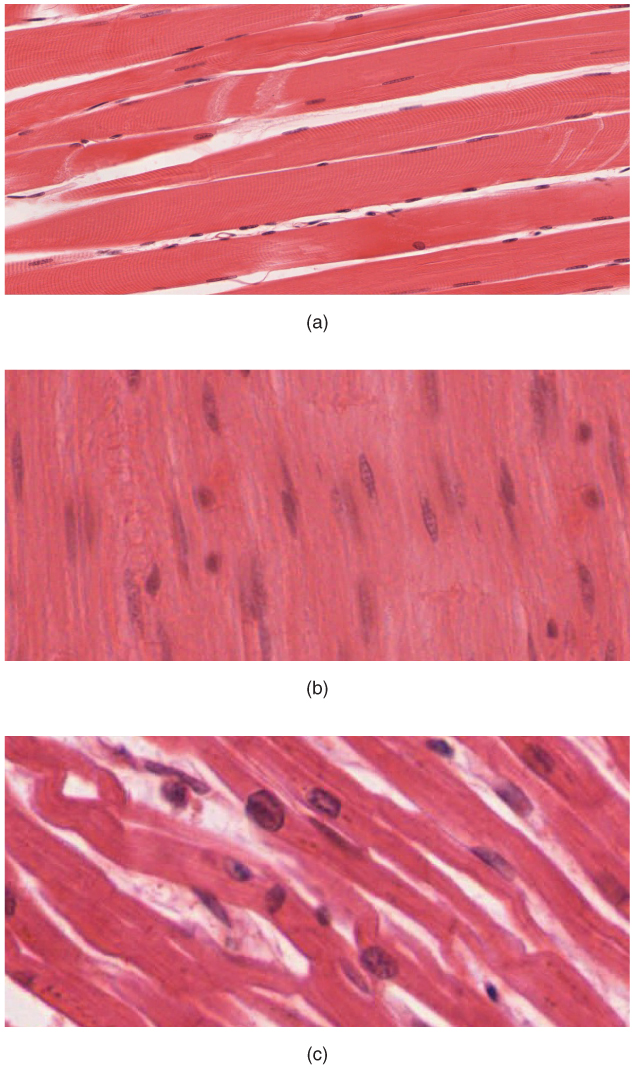
What muscle tissue is this? (b)
Smooth Muscle
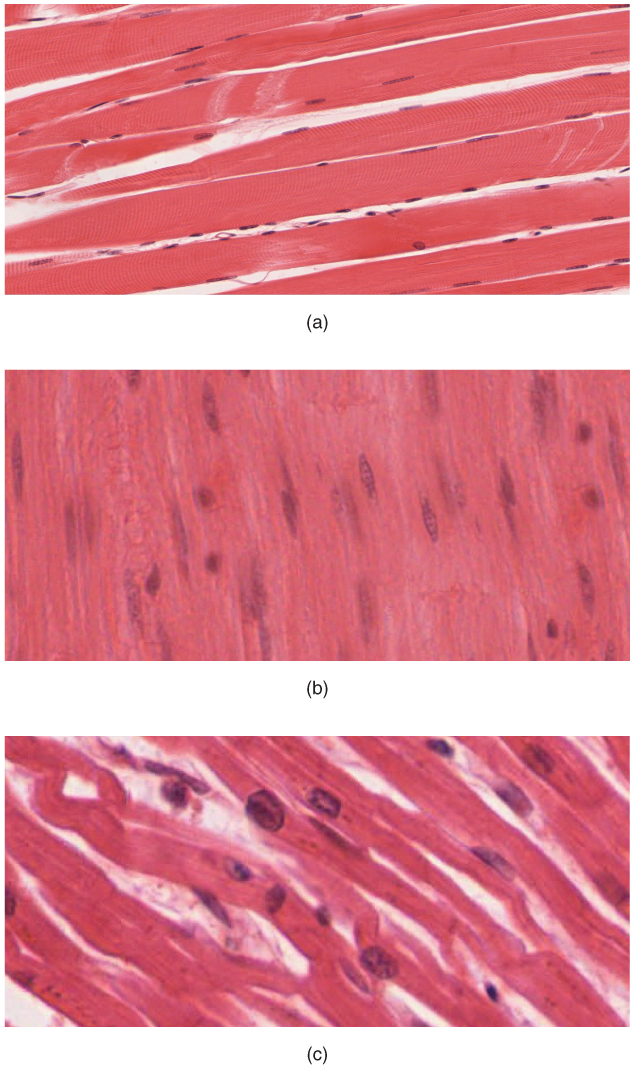
What muscle tissue is this? (c)
Cardiac Muscle
ALL 3 types of muscle tissues have?
Excitability
What is excitability?
Plasma membrane can change electrical state (from polarized to depolarized) and send electrical wave of action potential
What is elasticity?
A muscle that can return back to its original length
What is extensibility?
Muscle tissue that has the quality to be stretched or extended
What is contractility?
Allows muscle tissue to pull on its attachment points and shorten with force
What is the one difference between the three muscle types?
Their microscopic organization of their contractile proteins (actin and myosin)
What is another word for Muscle Fibers?
Muscle Cells
What are striations?
Stripes or patterns constructed by their organization of contractile proteins
What are the various integrated tissues of Skeletal Muscle?
Skeletal muscle fibers, blood vessels, nerve fibers, and connective tissue
What is another word for connective tissues in the Skeletal Muscle?
Mysia
What are the three connective tissues in the Skeletal Muscle?
Epimysium, perimysium, and endomysium
What is the epimysium?
Dense irregular connective tissue, that allows a muscle to contract and move powerfully while maintaining its structural integrity
What is a fascicle?
Muscle fibers that are organized into individual bundles
What is the perimysium?
Middle layer of connective tissue that wraps around the fascicle
What is the endomysium?
Thin connective tissue layer of collagen and reticular fibers that is inside each fascicle
What are the 4 functions of Skeletal Muscle?
Contract, control openings, protect, and heat
What is the sarcolemma?
The cell membrane of the skeletal muscle fibers
What is the sarcoplasm?
The cytoplasm of the skeletal muscle fibers
What is the sarcoplasmic reticulum (SR)?
Like the (SER) of the skeletal muscle fibers that stores, releases, and retrieves Calcium ions
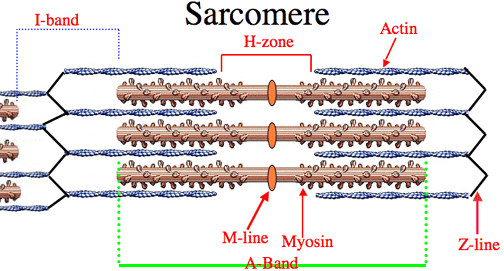
What is the sarcomere?
The functional unit of a skeletal muscle fiber that is highly organized in arrangement of the contractile myofilaments actin (thin filament) and myosin (thick filament), along with the other support proteins
Every Skeletal Muscle is richly supplied by what?
Blood vessels for nourishment, oxygen delivery, waste removal, and the axon branch of a somatic motor neuron, which signals the fiber to contract
Skeletal muscles are “excited” or stimulated by?
Signaling from the nervous system
Describe the skeletal muscle fiber.
Long and cylindrical, surrounded by the sarcolemma, which contains sarcoplasm
What does the Greek word sacro mean?
Flesh
A muscle fiber is composed of?
Many fibrils, which give the cell its striated appearance
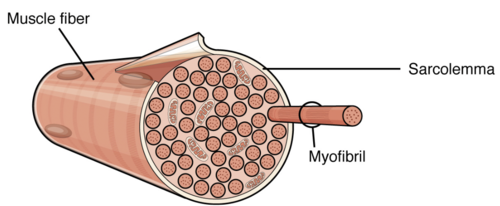
What are myofibril (fibrils or sarcostyle)?
long and cylindrical, rod-like structures that make up muscle fibers
What are myofilaments?
Protein filaments of myofibrils
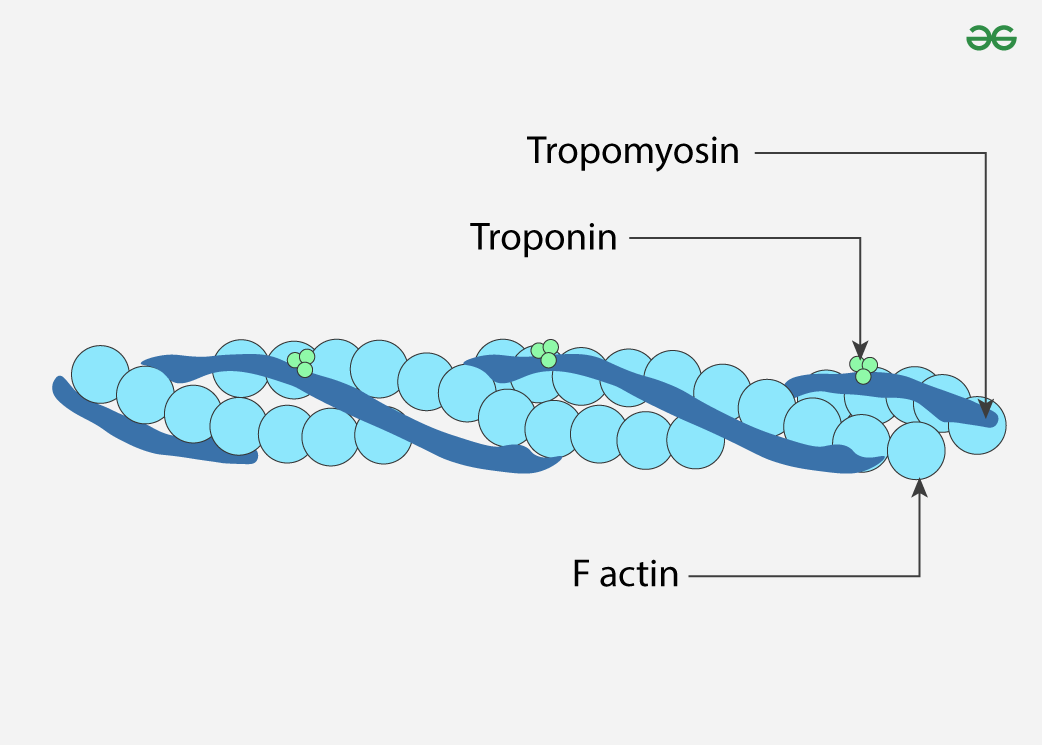
What are filaments?
A long chain of protein subunits that forms a thread-like structure
How do skeletal muscle fibers get their striated appearance?
By the arrangement of the myofilaments of actin and myosin in sequential order from one end of the muscle fiber to the other
What is troponin?
Regulatory protein that binds to actin, tropomyosin, and calcium
What is tropomyosin?
Regulatory protein that covers myosin-binding sites to prevent actin from binding to myosin
What is are the regulatory protein in muscles?
Troponin and tropomyosin
What are Z-discs or Z-lines?
They define the borders of an individual sarcomere
What is the purpose of the Z-discs or Z-lines?
It contains proteins which stabilize the arrangement, it is where thin filament attaches, it is the origin of the Titian protein, and it is the point at which Actin and Titian is crosslinked
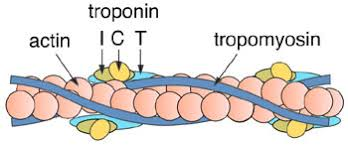
What are thin filaments?
Thin strands of actin and its troponin-tropomyosin complex (regulatory proteins) projecting from the Z-discs toward the center of the sarcomere
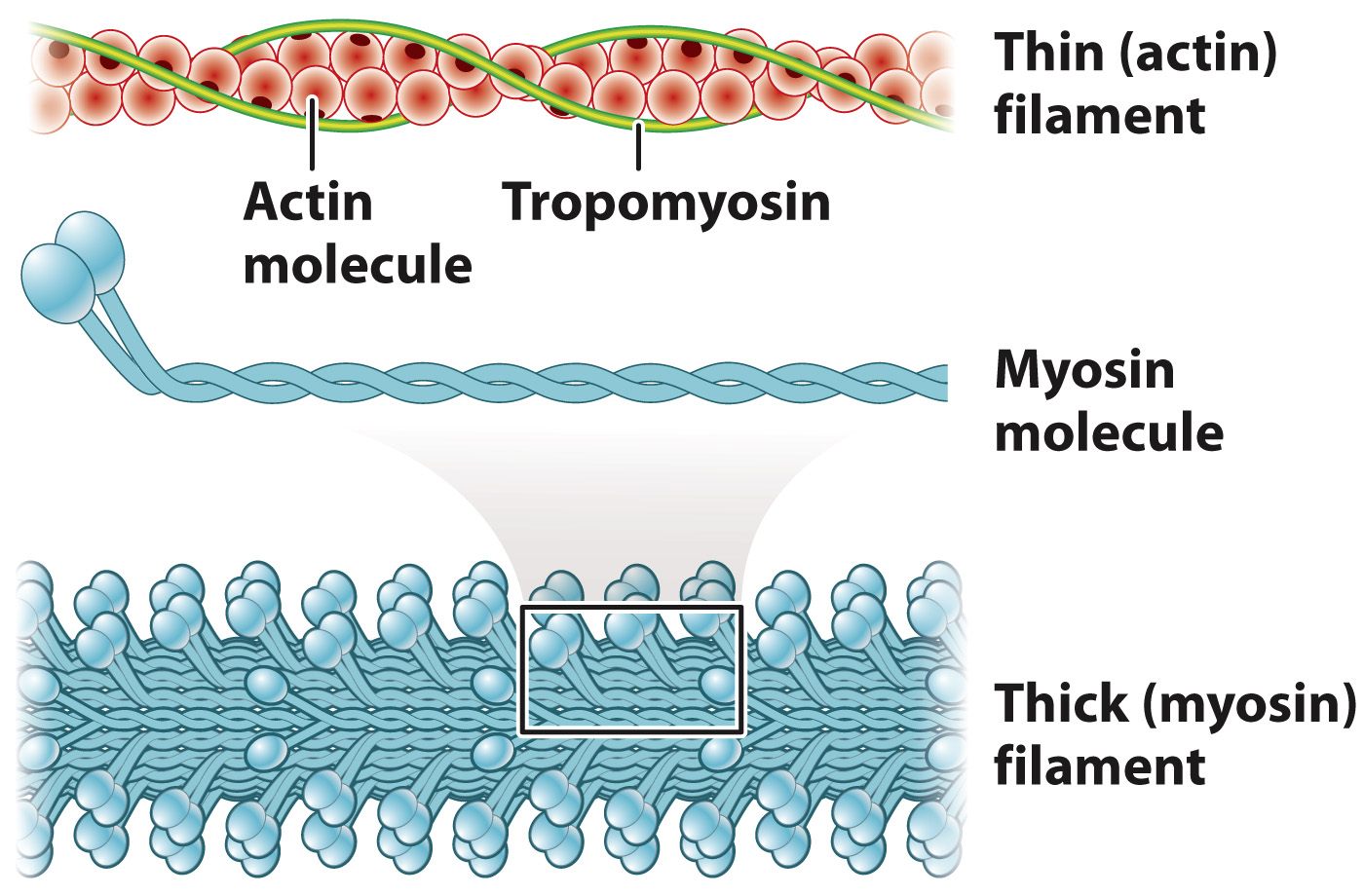
What are thick filaments?
Thick myosin strands and their multiple heads projecting from the center of the sarcomere toward, but not all the way to, the Z-discs
What is the sliding filament theory?
Explains how muscles contract by stating that muscle fibers shorten when the thin filaments (actin) slide past the thick filaments (myosin) within the muscle fiber, essentially pulling the filaments closer together without the filaments themselves changing length; this process requires energy from ATP and is considered the primary mechanism behind muscle contraction
What is the neuromuscular junction (NMJ)?
Is the point where a nerve cell (motor neuron) connects to a muscle fiber, allowing the nerve to send a signal that triggers the muscle to contract, essentially the “meeting point” between nerve and muscle that enables movement; it’s like a tiny bridge that lets electrical signals from the nerve jump across the muscle to initiate contraction
What is action potential?
Special type of electrical signal that can travel along a cell membrane as a wave. Allows signal to be transmitted quickly and faithfully over long distances
What is excitation-contraction coupling?
Sarcolemma is stimulated from electrical signals from action potential which then releases calcium ions from the SR. The calcium moves blocking proteins out of the way so that myosin can attach to actin. Myosin then pulls on actin, causing the muscle fiber to shorten and contract
What is the synaptic cleft?
The distance between neuron and muscle cells in the neuromuscular junction
What is the motor end-plate?
The location of the ACh-receptors in the muscle fiber sarcolemma
What is a neurotransmitter?
A chemical messenger that carries signals between neurons and muscles
What is acetylcholine (ACh)?
The specific neurotransmitter that tells muscles to contract
What does depolarize mean?
Change of electrical state, becomes more positive
What happens when ACh molecules are released in the NMJ?
They diffuse across a minute space (synaptic cleft) and bind to the receptors?
What are motor neurons?
Nerve cells that transmit signals from the brain and spinal cord to muscles, allowing for movement
What are axons?
Long processes which are specialized to transmit action potentials long distances
What is an example of axons?
The spinal cord to the muscle which is up to 3 ft away
What are nerves?
Axons of multiple neurons bundled together, like wires bundled together in a cable
What are neurons?
Nerve cells
What is voltage-gated sodium channels?
Proteins that open in response to changes in voltage, allowing sodium ions to flow into cells
The “T” in T-tubules stands for?
Transverse
What are T-tubules?
Transverse tubules, are extensions of the cell membrane that run through muscle fibers
What is the role of T-tubules?
Help transmit signals that trigger muscle contractions
What is a triad?
The grouping of one T-tubule and two terminal cisternae
What are terminal cisternae?
Two enlarged sacs of the SR that are located on either side of a T-tubule, forming a structure called a triad
What is the function of terminal cisternae?
Store calcium ions which are released into the muscle cell to trigger contraction when needed
What starts a muscle contraction?
A signal from a motor neuron at the NMJ. The neuron releases ACh, which binds to the muscle and starts an action potential
What happens after the action potential spreads through the muscle fiber?
Calcium is released from the SR. The action potential travels through T-tubules, triggering calcium release from the SR
Why is calcium important for muscle contraction?
Calcium removes the “block” so myosin can pull actin. Calcium binds to troponin, moving tropomyosin away from actin’s binding sites. This allows myosin to grab actin and pull (cross-bridge formation)
What is the sliding filament model?
Muscles contract when thin filaments (actin) slide past thick filaments (myosin). Myosin attaches to actin, pulls it toward the center of the sarcomere, then releases and resets. This cycle repeats, making the muscle contract
What is a power stroke?
The movement where myosin pulls actin. Myosin heads grab actin, pull it inward, and release
What does ATP do in muscle contraction?
ATP gives myosin energy to pull and reset. Without ATP, myosin would stay stuck to actin
What happens when a muscle relaxes?
Calcium goes back into the SR, blocking actin. No calcium means myosin can’t grab actin which means muscles stops contracting
What are the steps of the cross-bridge cycle?
Myosin grabs actin (cross-bridge forms), myosin pulls actin (power stroke), ATP binds to myosin (myosin lets go), and ATP is used to reset myosin for another pull
What happens if ATP runs out?
Muscles stay contracted (like in rigor mortis). ATP is needed to detach myosin from actin
What are the 3 ways muscles get ATP?
Creatine phosphate, glycolysis, and aerobic respiration
What is creatine phosphate?
A molecule that can store energy in its phosphate bonds
How long does creatine phosphate last?
15 seconds
What is glycolysis?
A process that breaks down glucose into ATP without oxygen
What is aerobic respiration?
The breakdown of glucose or other nutrients in the presence of oxygen to produce carbon dioxide, water, and ATP
What does creatine phosphate do?
Quickly makes ATP for short bursts of energy, only lasts 15 seconds before other systems take over
What glycolysis produces?
2 ATP and 2 molecules of pyruvic acid
When oxygen is absent in glycolysis, what happens to the 2 ATP and 2 pyruvic acid molecules?
Turn into lactic acid
What is lactic acid?
Made when muscles lack oxygen and can cause fatigue
Why does lactic acid matter?
Builds up during intense exercise when oxygen is low
Where does aerobic respiration happen?
Mitochondria
Aerobic respiration is..
Slower but produces 36 ATP per glucose (more energy)
What is oxygen debt?
The extra oxygen needed after exercise to restore energy and remove lactic acid. This is why you breathe hard after working out
What happens if a muscle keeps contracting for too long?
Muscle fatigue happens
What are the causes of muscle fatigue?
Low ATP, lactic acid buildup, and calcium imbalance in SR
What is ATPase?
An enzyme that breaks down ATP for energy which helps power muscle contraction
What is the role of the M-line?
The center of the sarcomere where myosin is anchored. Actin gets pulled towards the M-line during contraction
What does troponin do?
Binds to calcium and moves tropomyosin out of the way
What does tropomyosin do?
Blocks myosin from binding to actin when the muscle is relaxed
What is hypertrophy?
When muscle get bigger because more structural proteins (like myofibrils) are added, increasing muscle fiber diameter
What is ADP?
A molecule that is involved in transferring and providing cells with energy
What is muscle tension?
the “tightness” or “firmness” of a muscle
What does joint mean?
The connection point between two or more bones in your body
What does contract mean?
Muscle gets shorter, tighter, and uses energy